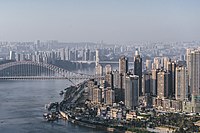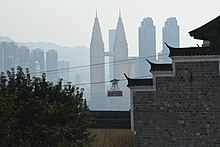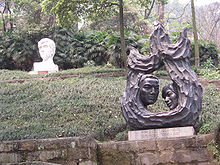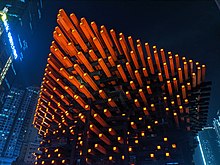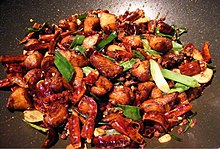Chongqing, China
The municipality of Chongqing is the only Chinese municipality with a resident population of over 30 million; however, this number includes its large rural population. In 2020, Chongqing surpassed Shanghai as China's largest municipality by urban population; as of 2022, it has an urban population of 22.8 million. The municipality contains 26 districts, 8 counties, and 4 autonomous counties. The city served as the wartime capital for the Republic of China (ROC) during the Second Sino-Japanese War (1937–1945). On 14 March 1997, the current municipality was separated from the surrounding province of Sichuan, with the goal of furthering development in the central and western parts of the country. University of Washington professor Kam Wing Chan argued that Chongqing's status is more akin to that of a province rather than a city.
As one of China's National Central Cities, Chongqing serves as a center for finance in the Sichuan Basin and the upstream Yangtze, as well as for manufacturing and transportation. It is a connection in the Yangtze River Economic Belt and a base for the country's Belt and Road Initiative. Chongqing Jiangbei International Airport is the second-busiest airport in China, and is one of the top 50 busiest airports in the world. The city's monorail system is the world's longest and busiest, as well as having the greatest number of stations, with 70. Chongqing is ranked as a Beta (global second-tier) city. It is the headquarters of the Changan Automobile, one of the "Big Four" car manufacturers of China. As of 2023, the city hosts 12 foreign representations, the fifth-most in China behind Beijing, Shanghai, Guangzhou, and Chengdu. It is one of the top 40 cities globally by scientific research output, as tracked by the Nature Index; the municipality is home to several notable universities, including Chongqing University, Southwest University, and Chongqing University of Posts and Telecommunications.
History
Antiquity
Chongqing's location is historically associated with the State of Ba. Its capital was first called Jiangzhou (江州).
Imperial era
Jiangzhou subsequently remained under Qin Shi Huang's rule during the Qin dynasty, the successor of the Qin State, as well as the rule of Han dynasty emperors. Jiangzhou was subsequently renamed during the Northern and Southern dynasties to Chu Prefecture (楚州), then again in 581 AD (Sui dynasty) to Yu Prefecture (渝州), and later in 1102 during Northern Song to Gong Prefecture (恭州). The name Yu however survives to this day as an abbreviation for Chongqing, as well as for the city's historic center, where the old town once stood; its name is Yuzhong (渝中, Central Yu). It received its current name in 1189, after Prince Zhao Dun of the Southern Song dynasty described his crowning as king and then Emperor Guangzong as a "double celebration" (simplified Chinese: 双重喜庆; traditional Chinese: 雙重喜慶; pinyin: shuāngchóng xǐqìng, or chóngqìng in short). To mark the occasion of his enthronement, Yu Prefecture was therefore converted to Chongqing Fu.
In 1362 (during the Yuan dynasty), Ming Yuzhen, a peasant rebel leader, established the Daxia Kingdom (大夏) at Chongqing for a short time. In 1621 (during the Ming dynasty), another short-lived kingdom of Daliang (大梁) was established by She Chongming (奢崇明) with Chongqing as its capital. In 1644, after the fall of the Ming dynasty to a rebel army, Chongqing, together with the rest of Sichuan, was captured by Zhang Xianzhong, who was said to have massacred a large number of people in Sichuan and depopulated the province, in part by causing many people to flee to safety elsewhere. The Manchus later conquered the province, and during the Qing dynasty, immigration to Chongqing and Sichuan took place with the support of the Qing emperor.
In 1890, the British Consulate General was opened in Chongqing. The following year, the city became the first inland commerce port open to foreigners, with the proviso that foreign ships should not be at liberty to trade there until Chinese-owned steamers had succeeded in ascending the river. This restriction was abolished by the Treaty of Shimonoseki in 1895, which declared the city open on the same terms as other ports, although it was not until 1907 that a steamship made the journey without the help of manual haulers. From 1896 to 1904, the American, German, French, and Japanese consulates were opened in Chongqing.
Provisional wartime capital of the Republic of China

During and after the Second Sino-Japanese War, from November 1937 to May 1946, it was Generalissimo Chiang Kai-shek's provisional capital. After the General and remaining army had lived there for a time following their retreat in 1938 from the previous capital of Wuhan, it was formally declared the second capital city (陪都; péidū; p'ei-tu) on 6 September 1940. After Britain, the United States, and other Allies entered the war in Asia in December 1941, one of the Allies' deputy commanders of operations in Southeast Asia (Southeast Asia Command SEAC), Joseph Stilwell, was based in the city.
The city was also visited by Lord Louis Mountbatten, the Supreme Commander of SEAC which was itself headquartered in Sri Lanka. Chiang Kai Shek as Supreme Commander in China worked closely with Stilwell. From 1938 to 1943, the city suffered from continuous massive bombing campaigns of the Imperial Japanese Navy and Army Air Forces; battles of which were fought entirely by the Chinese Air Force squadrons and anti-aircraft artillery units. Many lives were saved by the air-raid shelters which took advantage of the mountainous terrain. Chongqing was acclaimed to be the "City of Heroes" due to the indomitable spirits of its people as well as their contributions and sacrifices during the war. Many factories and universities were relocated from eastern China and ultimately to Chongqing during years of setbacks in the war, transforming this city from inland port to a heavily industrialized city.
Chinese Civil War
After World War II ended, Chongqing became one of the last refuges of the Nationalist Kuomintang government on the Chinese mainland during the Chinese Civil War. Following the Yangtze River Crossing campaign, the KMT capital of Nanjing was occupied by the Communists in 23 April. The KMT decamped first to Guangzhou, then Chongqing. Chongqing served as the KMT capital until late November 1949, when the Nationalist KMT government withdrew from the city by air.
Municipality status

On 14 March 1997, the Eighth National People's Congress decided to merge the sub-provincial city with adjacent Fuling, Wanxian, and Qianjiang prefectures that it had governed on behalf of the province since September 1996, and grant it independence from Sichuan. The resulting single entity became Chongqing Municipality, containing 30,020,000 people in forty-three former counties without intermediate political levels. The municipality became the spearhead of China's effort to develop its western regions and to coordinate the resettlement of residents from the reservoir areas of the Three Gorges Dam project. Its first official ceremony took place on 18 June 1997.
On 8 February 2010, Chongqing became one of the nine National Central Cities, along with Beijing, Tianjin, Chongqing, Shanghai, Guangzhou, Chengdu, Wuhan, Xi'an, and Zhengzhou. According to Zhou Liqun, a consultant for National Development and Reform Commission of China, Chongqing's status as a National Central City would encourage the development of Western China. Chongqing, which is located in central-western China, would complement the other National Central Cities, all of which are located along China's eastern coastline. The same year on June 18, the Liangjiang New Area was established in Chongqing, which was the third state-level new area at the time of its establishment.
Geography

Physical geography and topography

Chongqing is located in the subtropics, situated in the transitional area between the Tibetan Plateau and the plain on the middle and lower reaches of the Yangtze. Its climate features frequent monsoon conditions, often raining at night in late spring and early summer. The city's "night rain in the Ba Mountains", features in poems throughout Chinese history, including "Written on a Rainy Night—A Letter to the North" by Li Shangyin. Its territory is 470 km (290 mi) from east to west at its longest, and 450 km (280 mi) from north to south at its widest. It borders Hubei and Hunan to the east, Sichuan and Shaanxi to the north, and Guizhou to the south.

Chongqing covers a large area crisscrossed by rivers and mountains. The Daba Mountains stand in the north, the Wu Gorge in the east, the Wuling Mountains in the southeast, and the Dalou Mountains in the south. The area slopes downward from north to south towards the Yangtze valley, and features a large massif of mountains and hills, with steep sloping areas at different heights. Karst landscape is common in this area, and stone forests, numerous collections of peaks, limestone caves and valleys can be found in many places. The Longshuixia Gap (龙水峡地缝), with its Three Natural Bridges, has made the region a popular tourist attraction. The Yangtze River runs through the whole area from west to east, covering a course of 665 km (413 mi), cutting through the Wu Mountains at three places and forming the well-known Three Gorges: the Qutang, Wuxia and Xiling gorges. Coming from northwest and running through "the Jialing Lesser Three Gorges" of Libi, Wentang and Guanyin, the Jialing River joins the Yangtze in Chongqing.
Leaving at dawn the White Emperor crowned with cloud,
I've sailed a thousand li through canyons in a day.
With the monkeys' adieus the riverbanks are loud,
My skiff has left ten thousand mountains far away.— Li Bai's Poem of Chongqing's Baidi Cheng
The central urban area of Chongqing, called Chongqing proper, is built on mountains and partially surrounded by the Yangtze and Jialing rivers. With its special topography, Chongqing's topography includes mountains, rivers, forests, springs, waterfalls, gorges, and caves. The Tang dynasty poet Li Bai was inspired by the natural scenery and wrote this epigram.
The Zhongliang (中梁山) and Tongluo (铜锣山) mountains roughly form the eastern and western boundaries of Chongqing's urban area. Several high mountains are situated outside central Chongqing, including the 1,709.4 m (5,608 ft)-high Wugong Ling Mountain in Jiangjin.
Climate

Chongqing has a monsoonal humid subtropical climate (Köppen Cwa), bordering on a humid subtropical climate (Köppen Cfa) and for most of the year experiences very high relative humidity, with all months above 75%. Known as one of the "Three Furnaces" of the Yangtze River, along with Wuhan and Nanjing, its summers are long and among the hottest and most humid in China, with highs of 34 °C (93 °F) in July and August in the urban area. Winters are short and somewhat mild, but damp and overcast. The city's location in the Sichuan Basin causes it to have one of the lowest annual sunshine totals nationally, at only 983 hours, lower than much of Northern Europe; the monthly percent possible sunshine in the city proper ranges from a mere 5% in January to 43% in August. Extremes since 1951 have ranged from −1.8 °C (29 °F) on 11 January 1955 (unofficial record of −2.5 °C (27 °F) was set on 8 February 1943) to 43.7 °C (111 °F) on 18 and 19 August 2022 (unofficial record of 44.0 °C (111 °F) was set on 8 and 9 August 1933).
Chongqing, with over 100 days of fog per year, is known as the "Fog City" (雾都); this is because in the spring and fall, a thick layer of fog enshrouds it for 68 days per year. During the Second Sino-Japanese War (1937–1945), this special weather possibly played a role in protecting the city from being overrun by the Imperial Japanese Army.
| Climate data for Chongqing (Shapingba District), elevation 259 m (850 ft), (1991–2020 normals, extremes 1951–present) | |||||||||||||
|---|---|---|---|---|---|---|---|---|---|---|---|---|---|
| Month | Jan | Feb | Mar | Apr | May | Jun | Jul | Aug | Sep | Oct | Nov | Dec | Year |
| Record high °C (°F) | 18.8 (65.8) |
27.6 (81.7) |
34.0 (93.2) |
36.5 (97.7) |
38.9 (102.0) |
39.8 (103.6) |
42.0 (107.6) |
43.7 (110.7) |
42.0 (107.6) |
37.4 (99.3) |
29.6 (85.3) |
21.5 (70.7) |
43.7 (110.7) |
| Mean daily maximum °C (°F) | 10.4 (50.7) |
13.6 (56.5) |
18.6 (65.5) |
23.9 (75.0) |
27.4 (81.3) |
29.8 (85.6) |
33.7 (92.7) |
33.9 (93.0) |
28.5 (83.3) |
22.0 (71.6) |
17.3 (63.1) |
11.7 (53.1) |
22.6 (72.6) |
| Daily mean °C (°F) | 8.1 (46.6) |
10.4 (50.7) |
14.5 (58.1) |
19.2 (66.6) |
22.6 (72.7) |
25.4 (77.7) |
28.9 (84.0) |
28.9 (84.0) |
24.4 (75.9) |
18.9 (66.0) |
14.5 (58.1) |
9.5 (49.1) |
18.8 (65.8) |
| Mean daily minimum °C (°F) | 6.4 (43.5) |
8.3 (46.9) |
11.7 (53.1) |
16.0 (60.8) |
19.4 (66.9) |
22.4 (72.3) |
25.4 (77.7) |
25.3 (77.5) |
21.5 (70.7) |
16.8 (62.2) |
12.5 (54.5) |
8.0 (46.4) |
16.1 (61.0) |
| Record low °C (°F) | −1.8 (28.8) |
−0.8 (30.6) |
1.2 (34.2) |
2.8 (37.0) |
10.8 (51.4) |
15.5 (59.9) |
19.2 (66.6) |
17.8 (64.0) |
14.3 (57.7) |
6.9 (44.4) |
0.7 (33.3) |
−1.7 (28.9) |
−1.8 (28.8) |
| Average precipitation mm (inches) | 20.7 (0.81) |
22.4 (0.88) |
55.6 (2.19) |
103.4 (4.07) |
142.5 (5.61) |
212.1 (8.35) |
174.2 (6.86) |
125.7 (4.95) |
124.7 (4.91) |
95.3 (3.75) |
50.4 (1.98) |
24.7 (0.97) |
1,151.7 (45.33) |
| Average precipitation days (≥ 0.1 mm) | 10.0 | 8.9 | 11.5 | 13.6 | 16.0 | 16.0 | 11.3 | 11.5 | 12.6 | 15.8 | 11.3 | 10.6 | 149.1 |
| Average snowy days | 0.2 | 0.1 | 0 | 0 | 0 | 0 | 0 | 0 | 0 | 0 | 0 | 0.1 | 0.4 |
| Average relative humidity (%) | 82 | 78 | 75 | 75 | 76 | 79 | 73 | 70 | 77 | 84 | 83 | 84 | 78 |
| Mean monthly sunshine hours | 16.6 | 32.9 | 72.8 | 105.8 | 109.7 | 98.7 | 169.3 | 175.2 | 102.6 | 46.6 | 35.0 | 18.0 | 983.2 |
| Percent possible sunshine | 5 | 10 | 19 | 27 | 26 | 24 | 40 | 43 | 28 | 13 | 11 | 6 | 21 |
| Average ultraviolet index | 4 | 6 | 8 | 10 | 11 | 12 | 12 | 11 | 10 | 7 | 5 | 4 | 8 |
| Source 1: China Meteorological Administration | |||||||||||||
| Source 2: Weather Atlas (uv) | |||||||||||||
| Climate data for Chongqing (Yubei District), elevation 465 m (1,526 ft), (1991–2020 normals, extremes 1981–2010) | |||||||||||||
|---|---|---|---|---|---|---|---|---|---|---|---|---|---|
| Month | Jan | Feb | Mar | Apr | May | Jun | Jul | Aug | Sep | Oct | Nov | Dec | Year |
| Record high °C (°F) | 16.8 (62.2) |
23.7 (74.7) |
32.3 (90.1) |
34.1 (93.4) |
36.1 (97.0) |
35.6 (96.1) |
38.7 (101.7) |
41.7 (107.1) |
40.9 (105.6) |
33.1 (91.6) |
27.7 (81.9) |
17.9 (64.2) |
41.7 (107.1) |
| Mean daily maximum °C (°F) | 8.9 (48.0) |
12.0 (53.6) |
16.9 (62.4) |
22.2 (72.0) |
25.6 (78.1) |
28.0 (82.4) |
32.0 (89.6) |
32.3 (90.1) |
27.0 (80.6) |
20.6 (69.1) |
16.0 (60.8) |
10.2 (50.4) |
21.0 (69.8) |
| Daily mean °C (°F) | 6.7 (44.1) |
9.0 (48.2) |
13.2 (55.8) |
18.0 (64.4) |
21.4 (70.5) |
24.1 (75.4) |
27.6 (81.7) |
27.6 (81.7) |
23.1 (73.6) |
17.7 (63.9) |
13.2 (55.8) |
8.0 (46.4) |
17.5 (63.5) |
| Mean daily minimum °C (°F) | 5.1 (41.2) |
7.1 (44.8) |
10.6 (51.1) |
15.0 (59.0) |
18.4 (65.1) |
21.3 (70.3) |
24.2 (75.6) |
24.1 (75.4) |
20.4 (68.7) |
15.7 (60.3) |
11.4 (52.5) |
6.5 (43.7) |
15.0 (59.0) |
| Record low °C (°F) | −7.4 (18.7) |
0.2 (32.4) |
0.0 (32.0) |
4.9 (40.8) |
9.6 (49.3) |
14.0 (57.2) |
18.2 (64.8) |
17.4 (63.3) |
13.2 (55.8) |
6.2 (43.2) |
2.6 (36.7) |
−2.8 (27.0) |
−7.4 (18.7) |
| Average precipitation mm (inches) | 19.6 (0.77) |
22.6 (0.89) |
55.2 (2.17) |
101.2 (3.98) |
154.8 (6.09) |
205.6 (8.09) |
167.4 (6.59) |
130.9 (5.15) |
129.3 (5.09) |
104.8 (4.13) |
52.4 (2.06) |
24.4 (0.96) |
1,168.2 (45.97) |
| Average precipitation days (≥ 0.1 mm) | 9.9 | 9.4 | 12.0 | 14.1 | 16.5 | 16.2 | 12.3 | 10.9 | 13.0 | 16.7 | 11.9 | 11.2 | 154.1 |
| Average snowy days | 1.0 | 0.4 | 0 | 0 | 0 | 0 | 0 | 0 | 0 | 0 | 0 | 0.2 | 1.6 |
| Average relative humidity (%) | 83 | 79 | 75 | 76 | 82 | 75 | 72 | 79 | 85 | 84 | 85 | 79 | 80 |
| Mean monthly sunshine hours | 35.9 | 45.5 | 85.8 | 116.9 | 126 | 112 | 195.8 | 208.4 | 127.7 | 70.4 | 59.4 | 34.9 | 1,218.7 |
| Percent possible sunshine | 11 | 14 | 23 | 30 | 30 | 27 | 46 | 51 | 35 | 20 | 19 | 11 | 26 |
| Source: China Meteorological Administration | |||||||||||||
| Climate data for NE Chongqing (Wushan County), elevation 276 m (906 ft), (1991–2020 normals, extremes 1981–2010) | |||||||||||||
|---|---|---|---|---|---|---|---|---|---|---|---|---|---|
| Month | Jan | Feb | Mar | Apr | May | Jun | Jul | Aug | Sep | Oct | Nov | Dec | Year |
| Record high °C (°F) | 21.8 (71.2) |
27.5 (81.5) |
34.3 (93.7) |
37.5 (99.5) |
40.8 (105.4) |
41.9 (107.4) |
42.1 (107.8) |
42.8 (109.0) |
42.2 (108.0) |
35.5 (95.9) |
26.4 (79.5) |
20.7 (69.3) |
42.8 (109.0) |
| Mean daily maximum °C (°F) | 10.9 (51.6) |
13.6 (56.5) |
18.6 (65.5) |
24.3 (75.7) |
27.9 (82.2) |
31.3 (88.3) |
34.1 (93.4) |
34.3 (93.7) |
29.7 (85.5) |
23.6 (74.5) |
18.3 (64.9) |
12.4 (54.3) |
23.2 (73.8) |
| Daily mean °C (°F) | 7.5 (45.5) |
9.7 (49.5) |
13.6 (56.5) |
18.8 (65.8) |
22.5 (72.5) |
26 (79) |
28.6 (83.5) |
28.5 (83.3) |
24.6 (76.3) |
19.1 (66.4) |
14.3 (57.7) |
9.2 (48.6) |
18.5 (65.4) |
| Mean daily minimum °C (°F) | 5.0 (41.0) |
7.0 (44.6) |
10.0 (50.0) |
14.8 (58.6) |
18.7 (65.7) |
22.2 (72.0) |
24.7 (76.5) |
24.5 (76.1) |
21.1 (70.0) |
16.1 (61.0) |
11.5 (52.7) |
6.9 (44.4) |
15.2 (59.4) |
| Record low °C (°F) | −2.1 (28.2) |
−0.2 (31.6) |
1.6 (34.9) |
3.4 (38.1) |
11.4 (52.5) |
15.5 (59.9) |
18.6 (65.5) |
17.2 (63.0) |
13.1 (55.6) |
5.8 (42.4) |
3.1 (37.6) |
−3.4 (25.9) |
−3.4 (25.9) |
| Average precipitation mm (inches) | 10.9 (0.43) |
24.9 (0.98) |
42.6 (1.68) |
87.5 (3.44) |
142.2 (5.60) |
143.4 (5.65) |
166.7 (6.56) |
132.4 (5.21) |
108 (4.3) |
86.2 (3.39) |
46.9 (1.85) |
14.9 (0.59) |
1,006.6 (39.68) |
| Average precipitation days (≥ 0.1 mm) | 5.4 | 6.4 | 10.3 | 13.4 | 14.4 | 12.9 | 13.0 | 11.0 | 10.7 | 12.3 | 9.1 | 6.9 | 125.8 |
| Average snowy days | 1.5 | 0.5 | 0.2 | 0 | 0 | 0 | 0 | 0 | 0 | 0 | 0 | 0.3 | 2.5 |
| Average relative humidity (%) | 65 | 63 | 63 | 66 | 70 | 71 | 71 | 67 | 68 | 72 | 71 | 69 | 68 |
| Mean monthly sunshine hours | 74.1 | 71.9 | 111.9 | 133.7 | 144.4 | 156.7 | 194.1 | 202.6 | 147.8 | 117.1 | 101.7 | 76.5 | 1,532.5 |
| Percent possible sunshine | 23 | 23 | 30 | 34 | 34 | 37 | 45 | 50 | 40 | 34 | 32 | 24 | 34 |
| Source: China Meteorological Administration | |||||||||||||
Cityscape
-
Jiangbeizui CBD from above, taken in 2018
-
Jiefangbei (解放碑; 'People's Liberation Monument') is a World War II victory monument.
-
Raffles City Chongqing, sitting in the confluence of Yangtze and Jialing River
Politics

Since 1997, Chongqing has been a direct-controlled municipality in the Chinese administrative structure, making it a provincial-level division with commensurate political importance. The municipality's leader is Secretary of the Municipal Committee of the Chinese Communist Party, which, since 2007, has also held a seat on the Politburo of the Chinese Communist Party, the country's second highest governing council. Under the USSR-inspired nomenklatura system of appointments, individuals are appointed to the position by the central leadership of the CCP and bestowed to an official based on seniority and adherence to party orthodoxy, usually given to an individual with prior regional experience elsewhere in China and nearly never a native of Chongqing. Notable individuals who have held the municipal Party Secretary position include He Guoqiang, Wang Yang, Bo Xilai, Zhang Dejiang, and Sun Zhengcai, the latter three were Politburo members during their term as party chief. The party chief heads the municipal party standing committee, the de facto top governing council of the municipality. The standing committee is typically composed of 13 individuals which includes the party chiefs of important subdivisions and other leading figures in the local party and government organization, as well as one military representative.
The municipal People's Government serves as the day-to-day administrative authority, and is headed by the mayor, who is assisted by numerous vice mayors and mayoral assistants. Each vice mayor is given jurisdiction over specific municipal departments. The mayor is the second-highest-ranking official in the municipality. The mayor usually represents the city when foreign guests visit.
The municipality also has a Municipal People's Congress, theoretically elected by lower level People's Congresses. The People's Congress nominally appoints the mayor and approves the nominations of other government officials. The People's Congress, like those of other provincial jurisdictions, is generally seen as a symbolic body. It convenes in full once a year to approve party-sponsored resolutions and local regulations and duly confirm party-approved appointments. On occasion the People's Congress can be venues of discussion on municipal issues, although this is dependent on the actions of individual delegates. The municipal People's Congress is headed by a former municipal official, usually in their late fifties or sixties, with a lengthy prior political career in Chongqing. The municipal Political Consultative Conference (zhengxie) meets at around the same time as the People's Congress. Its role is to advise on political issues. The zhengxie is headed by a leader who is typically a former municipal or regional official with a lengthy career in the party and government bureaucracy.
Military
Chongqing was the wartime capital of China during the Second Sino-Japanese War (i.e., World War II), and from 1937 to 1945, the seat of administration for the Republic of China's government before its departure to Nanjing and then Taiwan. After the eventual defeat at the Battle of Wuhan General Chiang-Kai Shek and the army were forced to use it as base of resistance from 1938 onwards. It also contains a military museum named after the Chinese Korean War hero Qiu Shaoyun.
Chongqing used to be the headquarters of the 13th Group Army of the People's Liberation Army, one of the two group armies that formerly comprised the Chengdu Military Region, which was reorganized into the Western Theater Command in 2016.
Administrative divisions
Chongqing is the largest of the four direct-controlled municipalities of the People's Republic of China. The municipality is divided into 38 subdivisions (3 were abolished in 1997, and Wansheng and Shuangqiao districts were abolished in October 2011), consisting of 26 districts, 8 counties, and 4 autonomous counties. The boundaries of Chongqing municipality reach much farther into the city's hinterland than the boundaries of the other three provincial level municipalities (Beijing, Shanghai and Tianjin), and much of its administrative area, which spans over 80,000 km (30,900 sq mi), is rural. At the end of year 2018, the total population is 31.02 million. As of 2022, Chongqing is the largest Chinese city by urban population, with a population of 22.80 million.
| Administrative divisions of Chongqing | ||||||||||||||
|---|---|---|---|---|---|---|---|---|---|---|---|---|---|---|
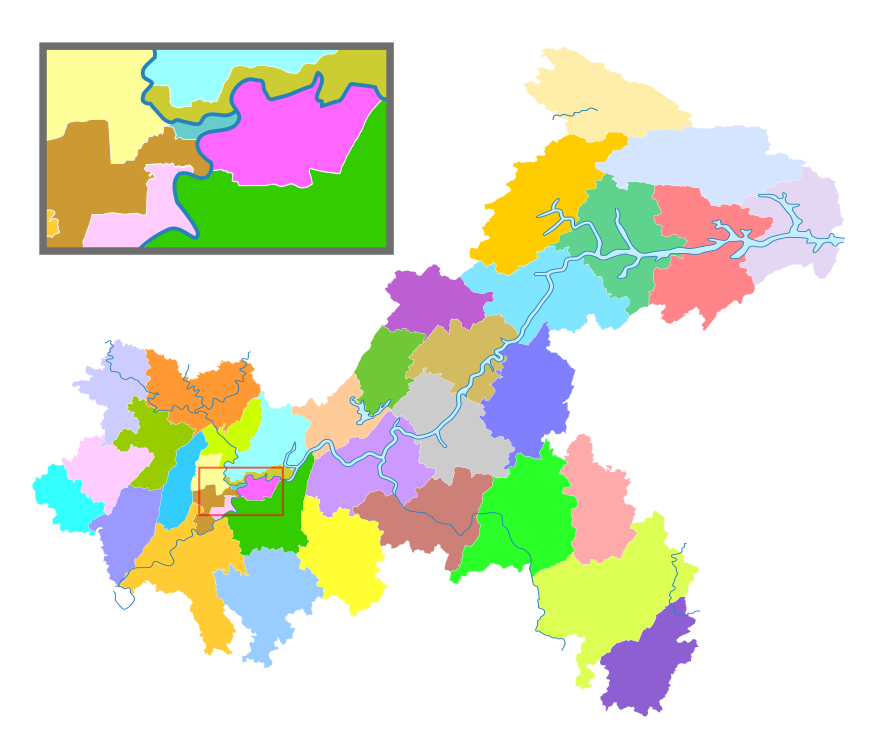
| ||||||||||||||
| Division code | Division | Area in km | Total population 2010 | Urban area population 2010 |
Seat | Postal code | Subdivisions | |||||||
| Subdistricts | Towns | Townships |
Ethnic townships | Residential communities | Villages | |||||||||
| 500000 | Chongqing | 82403 | 28,846,170 | 15295803 | Yuzhong | 400000 | 181 | 567 | 233 | 14 | 2324 | 5235 | ||
| 500101 | Wanzhou | 3457 | 1,563,050 | 859,662 | Chenjiaba Subdistrict | 404000 | 11 | 29 | 10 | 2 | 187 | 448 | ||
| 500102 | Fuling | 2946 | 1,066,714 | 595,224 | Lizhi Subdistrict | 408000 | 8 | 12 | 6 | 108 | 310 | |||
| 500103 | Yuzhong | 23 | 630,090 | Qixinggang Subdistrict | 400000 | 12 | 78 | |||||||
| 500104 | Dadukou | 102 | 301,042 | 280,512 | Xinshancun Subdistrict | 400000 | 5 | 2 | 48 | 32 | ||||
| 500105 | Jiangbei | 221 | 738,003 | 672,545 | Cuntan Subdistrict | 400000 | 9 | 3 | 88 | 48 | ||||
| 500106 | Shapingba | 396 | 1,000,013 | 900,568 | Qinjiagang Subdistrict | 400000 | 18 | 8 | 140 | 86 | ||||
| 500107 | Jiulongpo | 431 | 1,084,419 | 939,349 | Yangjiaping Subdistrict | 400000 | 7 | 11 | 107 | 105 | ||||
| 500108 | Nan'an | 263 | 759,570 | 683,717 | Tianwen Subdistrict | 400000 | 7 | 7 | 85 | 61 | ||||
| 500109 | Beibei | 754 | 680,360 | 501,822 | Beiwenquan Subdistrict | 400700 | 5 | 12 | 63 | 117 | ||||
| 500110 | Qijiang | 2747 | 1,056,817 | 513,935 | Gunan Subdistrict | 400800 | 5 | 25 | 99 | 365 | ||||
| 500111 | Dazu | 1433 | 721,359 | 315,183 | Tangxiang Subdistrict | 400900 | 3 | 24 | 103 | 197 | ||||
| 500112 | Yubei | 1452 | 1,345,410 | 985,918 | Shuangfengqiao Subdistrict | 401100 | 14 | 12 | 155 | 215 | ||||
| 500113 | Banan | 1834 | 918,692 | 669,269 | Longzhouwan Subdistrict | 401300 | 8 | 14 | 87 | 198 | ||||
| 500114 | Qianjiang | 2397 | 445,012 | 173,997 | Chengxi Subdistrict | 409700 | 6 | 12 | 12 | 80 | 138 | |||
| 500115 | Changshou | 1423 | 770,009 | 408,261 | Fengcheng Subdistrict | 401200 | 4 | 14 | 31 | 223 | ||||
| 500116 | Jiangjin | 3200 | 1,233,149 | 686,189 | Jijiang Subdistrict | 402200 | 4 | 24 | 85 | 180 | ||||
| 500117 | Hechuan | 2356 | 1,293,028 | 721,753 | Nanjin Street Subdistrict | 401500 | 7 | 23 | 61 | 327 | ||||
| 500118 | Yongchuan | 1576 | 1,024,708 | 582,769 | Zhongshan Road Subdistrict | 402100 | 7 | 16 | 52 | 208 | ||||
| 500119 | Nanchuan | 2602 | 534,329 | 255,045 | Dongcheng Subdistrict | 408400 | 3 | 15 | 15 | 58 | 185 | |||
| 500120 | Bishan | 912 | 586,034 | 246,425 | Bicheng Subdistrict | 402700 | 6 | 9 | 43 | 142 | ||||
| 500151 | Tongliang | 1342 | 600,086 | 248,962 | Bachuan Subdistrict | 402500 | 3 | 25 | 57 | 269 | ||||
| 500152 | Tongnan | 1585 | 639,985 | 247,084 | Guilin Subdistrict | 402600 | 2 | 20 | 21 | 281 | ||||
| 500153 | Rongchang | 1079 | 661,253 | 271,232 | Changyuan Subdistrict | 402400 | 6 | 15 | 75 | 92 | ||||
| 500154 | Kaizhou | 3959 | 1,160,336 | 416,415 | Hanfeng Subdistrict | 405400 | 7 | 26 | 7 | 78 | 435 | |||
| 500155 | Liangping | 1890 | 687,525 | 235,753 | Liangshan Subdistrict | 405200 | 2 | 26 | 7 | 33 | 310 | |||
| 500156 | Wulong | 2872 | 351,038 | 115,823 | Gangkou town | 408500 | 12 | 10 | 4 | 24 | 184 | |||
| 500229 | Chengkou Co. | 3286 | 192,967 | 49,039 | Gecheng Subdistrict | 405900 | 2 | 6 | 17 | 22 | 184 | |||
| 500230 | Fengdu Co. | 2896 | 649,182 | 224,003 | Sanhe Subdistrict | 408200 | 2 | 23 | 5 | 53 | 277 | |||
| 500231 | Dianjiang Co. | 1518 | 704,458 | 241,424 | Guixi Subdistrict | 408300 | 2 | 23 | 2 | 62 | 236 | |||
| 500233 | Zhong Co. | 2184 | 751,424 | 247,406 | Zhongzhou town | 404300 | 22 | 5 | 1 | 49 | 317 | |||
| 500235 | Yunyang Co. | 3634 | 912,912 | 293,636 | Shuangjiang Subdistrict | 404500 | 4 | 22 | 15 | 1 | 87 | 391 | ||
| 500236 | Fengjie Co. | 4087 | 834,259 | 269,302 | Yong'an town | 404600 | 19 | 8 | 4 | 54 | 332 | |||
| 500237 | Wushan Co. | 2958 | 495,072 | 148,597 | Gaotang Subdistrict | 404700 | 11 | 12 | 2 | 30 | 308 | |||
| 500238 | Wuxi Co. | 4030 | 414,073 | 105,111 | Baichang Subdistrict | 405800 | 2 | 15 | 16 | 38 | 292 | |||
| 500240 | Shizhu Co. | 3013 | 415,050 | 134,173 | Nanbin town | 409100 | 17 | 15 | 29 | 213 | ||||
| 500241 | Xiushan Co. | 2450 | 501,590 | 150,566 | Zhonghe Subdistrict | 409900 | 14 | 18 | 59 | 208 | ||||
| 500242 | Youyang Co. | 5173 | 578,058 | 137,635 | Taohuayuan town | 409800 | 15 | 23 | 8 | 270 | ||||
| 500243 | Pengshui Co. | 3903 | 545,094 | 137,409 | Hanjia Subdistrict | 409600 | 11 | 28 | 55 | 241 | ||||
| Divisions in Chinese and varieties of romanizations | ||||
|---|---|---|---|---|
| English | Chinese | Hanyu Pinyin | Sichuanese Pinyin | |
| Chongqing Municipality | 重庆市 | Chóngqìng Shì | cong qin si | |
| Wanzhou District | 万州区 | Wànzhōu Qū | wan zou qu | |
| Fuling District | 涪陵区 | Fúlíng Qū | ||
| Yuzhong District | 渝中区 | Yúzhōng Qū | yu zong qu | |
| Dadukou District | 大渡口区 | Dàdùkǒu Qū | da du kou qu | |
| Jiangbei District | 江北区 | Jiāngběi Qū | jiang be qu | |
| Shapingba District | 沙坪坝区 | Shāpíngbà Qū | sa pin ba qu | |
| Jiulongpo District | 九龙坡区 | Jiǔlóngpō Qū | ||
| Nan'an District | 南岸区 | Nán'àn Qū | lan ngan qu | |
| Beibei District | 北碚区 | Běibèi Qū | ||
| Qijiang District | 綦江区 | Qíjiāng Qū | ||
| Dazu District | 大足区 | Dàzú Qū | ||
| Yubei District | 渝北区 | Yúběi Qū | yu be qu | |
| Banan District | 巴南区 | Bānán Qū | ba lan qu | |
| Qianjiang District | 黔江区 | Qiánjiāng Qū | ||
| Changshou District | 长寿区 | Chángshòu Qū | ||
| Jiangjin District | 江津区 | Jiāngjīn Qū | jiang jin qu | |
| Hechuan District | 合川区 | Héchuān Qū | ho cuan qu | |
| Yongchuan District | 永川区 | Yǒngchuān Qū | yun cuan qu | |
| Nanchuan District | 南川区 | Nánchuān Qū | lan cuan qu | |
| Bishan District | 璧山区 | Bìshān Qū | ||
| Tongliang District | 铜梁区 | Tóngliáng Qū | ||
| Tongnan District | 潼南区 | Tóngnán Qū | ||
| Rongchang District | 荣昌区 | Róngchāng Qū | ||
| Kaizhou District | 开州区 | Kāizhōu Qū | kai zou qu | |
| Liangping District | 梁平区 | Liángpíng Qū | ||
| Wulong District | 武隆区 | Wǔlóng Qū | wu nong qu | |
| Chengkou County | 城口县 | Chéngkǒu Xiàn | cen kou xian | |
| Fengdu County | 丰都县 | Fēngdū Xiàn | ||
| Dianjiang County | 垫江县 | Diànjiāng Xiàn | ||
| Zhong County | 忠县 | Zhōngxiàn | zong xian | |
| Yunyang County | 云阳县 | Yúnyáng Xiàn | yun yang xian | |
| Fengjie County | 奉节县 | Fèngjié Xiàn | ||
| Wushan County | 巫山县 | Wūshān Xiàn | ||
| Wuxi County | 巫溪县 | Wūxī Xiàn | ||
| Shizhu Tujia Autonomous County | 石柱土家族自治县 | Shízhù Tǔjiāzú Zìzhìxiàn | ||
| Xiushan Tujia and Miao Autonomous County | 秀山土家族苗族自治县 | Xiùshān Tǔjiāzú Miáozú Zìzhìxiàn | ||
| Youyang Tujia and Miao Autonomous County | 酉阳土家族苗族自治县 | Yǒuyáng Tǔjiāzú Miáozú Zìzhìxiàn | ||
| Pengshui Miao and Tujia Autonomous County | 彭水苗族土家族自治县 | Péngshuǐ Miáozú Tǔjiāzú Zìzhìxiàn | ||
- ^ Including other township related subdivisions.
Urban areas
| Population by urban areas of districts | |||||
|---|---|---|---|---|---|
| # | City | Urban area | District area | Census date | |
| 1 | Chongqing | 6,263,790 | 7,457,599 | 2010-11-01 | |
| 2 | Wanzhou | 859,662 | 1,563,050 | 2010-11-01 | |
| 3 | Hechuan | 721,753 | 1,293,028 | 2010-11-01 | |
| 4 | Jiangjin | 686,189 | 1,233,149 | 2010-11-01 | |
| 5 | Fuling | 595,224 | 1,066,714 | 2010-11-01 | |
| 6 | Yongchuan | 582,769 | 1,024,708 | 2010-11-01 | |
| 7 | Qijiang | 513,935 | 1,056,817 | 2010-11-01 | |
| (8) | Kaizhou | 416,415 | 1,160,336 | 2010-11-01 | |
| 9 | Changshou | 408,261 | 770,009 | 2010-11-01 | |
| 10 | Dazu | 315,183 | 721,359 | 2010-11-01 | |
| (11) | Rongchang | 271,232 | 661,253 | 2010-11-01 | |
| 12 | Nanchuan | 255,045 | 534,329 | 2010-11-01 | |
| (13) | Tongliang | 248,962 | 600,086 | 2010-11-01 | |
| (14) | Tongnan | 247,084 | 639,985 | 2010-11-01 | |
| (15) | Bishan | 246,425 | 586,034 | 2010-11-01 | |
| (16) | Liangping | 235,753 | 687,525 | 2010-11-01 | |
| 17 | Qianjiang | 173,997 | 445,012 | 2010-11-01 | |
| (18) | Wulong | 115,823 | 351,038 | 2010-11-01 | |
- ^ Chongqing core districts are consist of nine districts: Yuzhong, Dadukou, Jiangbei, Shapingba, Jiulongpo, Nan'an, Beibei, Yubei, & Banan.
- ^ Wansheng District & Qijiang County currently known as Qijiang District after census.
- ^ Kaizhou County is currently known as Kaizhou District after census.
- ^ Shuangqiao District & Dazu County currently known as Dazu District after census.
- ^ Rongchang County is currently known as Rongchang District after census.
- ^ Tongliang County is currently known as Tongliang District after census.
- ^ Tongnan County is currently known as Tongnan District after census.
- ^ Bishan County is currently known as Bishan District after census.
- ^ Liangping County is currently known as Liangping District after census.
- ^ Wulong County is currently known as Wulong District after census.
|
|
|
Indicates with which district the division was associated below prior to the merging of Chongqing, Fuling, Wanxian (now Wanzhou) and Qianjiang in 1997.
Central Chongqing
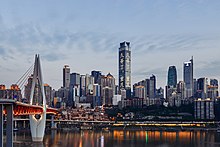
The main urban area of Chongqing city (重庆主城区) spans approximately 5,473 km (2,113 sq mi), and includes the following nine districts:
- Yuzhong District (渝中区, literally "Central Chongqing District"), the central and most densely populated district, where government and international business offices and the city's best shopping are located in the district's Jiefangbei CBD area. Yuzhong is located on the peninsula surrounded by Eling Hill, Yangtze River and Jialing River.
- Jiangbei District (江北区, literally "North of the River District"), located to the north of Jialing River.
- Shapingba District (沙坪坝区), roughly located between Jialing River and Zhongliang Mountain.
- Jiulongpo District (九龙坡区), roughly located between Yangtze River and Zhongliang Mountain.
- Nan'an District (南岸区, literally "Southern Bank District"), located on the south side of Yangtze River.
- Dadukou District (大渡口区)
- Banan District (巴南区, literally "Southern of Ba District"). Previously called Ba County, and changed to the current name in 1994.
- Yubei District (渝北区, or "Northern Chongqing District"). Previously called Jiangbei County, and changed into the current name in 1994.
- Beibei District (北碚区), a satellite district northwest of Chongqing.
Demographics
Population

| Year | Pop. | ±% |
|---|---|---|
| 1949 | 1,003,000 | — |
| 1979 | 6,301,000 | +528.2% |
| 1983 | 13,890,000 | +120.4% |
| 1996 | 15,297,000 | +10.1% |
| 1997* | 28,753,000 | +88.0% |
| 2000 | 28,488,200 | −0.9% |
| 2005 | 27,980,000 | −1.8% |
| 2008 | 28,390,000 | +1.5% |
| 2012 | 28,846,170 | +1.6% |
| 2013 | 29,700,000 | +3.0% |
| 2014 | 29,914,000 | +0.7% |
| 2015 | 30,170,000 | +0.9% |
| *Population size in 1997 was affected by expansion of administrative divisions. | ||
According to the 2020 national census, Chongqing has a population of 32,054,159, accounting for around 2.27% of the national total. This makes it the most populous city proper in the world. As of 2010, the metropolitan area encompassing the central urban area was estimated by the OECD to have, a population of 17 million.
The Census also lists the male percentage as 50.55% and the female percentage as 49.55%. In terms of age distribution, of the total population, 15.91% were age 0–14, 62.22% were 15–64, and 21.87% were 65 and over. Of the population's highest education level achieved, 15.41% were college, 15.96% were high school, 30.58% were middle school, and 29.89% were elementary school. As of 2021, 70.4% of Chongqing's population is estimated to be urban, and 29.6% rural.
Religion
Religion in Chongqing
The predominant religions in Chongqing are Chinese folk religions, Taoist traditions and Chinese Buddhism. According to surveys conducted in 2007 and 2009, 26.63% of the population practices Chinese ancestral religion, while 1.05% of the population identifies as Christian.
The reports did not give figures for other types of religion; 72.32% of the population may be either irreligious or involved in worship of nature deities, Buddhism, Confucianism, Taoism, or folk religious sects.
In 2010, there were 9,056 Muslims in Chongqing.


